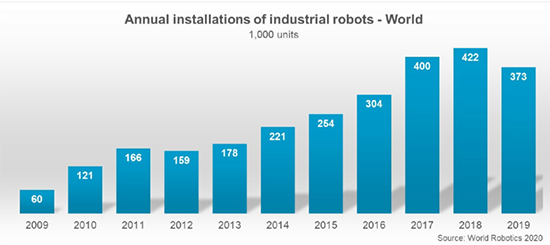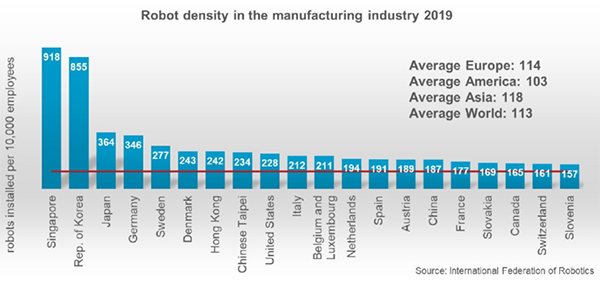
Support Team
Feedback:
support@nextpcb.comThe news of the price increase in this period has been heard constantly. The copper price has risen, steel has risen, crystal circles have risen, chips have risen... What makes the industry feel worse is that not only the price increase has not yet been available. I heard that some factories had to stop work because they couldn't get chips. But just when the price rise is not news, electronic enthusiasts found that some enterprises even sold industrial robots against the market price.
In the reducer, controller, servo system, and sensor of the four key parts of industrial robots, in addition to the reducer, the other three require chips. Among them, the controller and servo system use more chips.
The controller of an industrial robot can be said to be the brain of the entire robot control system. Its main task is to control the position, posture, and trajectory of the robot in the workspace through the combination of various hardware and software.
At present, domestic motion control technology has been greatly developed. At this year's machinery exhibition, found that many domestic controller companies participated in the exhibition, such as Xindai, Huacheng CNC, Zhongweixing, Leisa Intelligent, Collier, and so on. The hardware of domestic control boards has gradually matured. Compared with the control boards of large foreign manufacturers, the hardware gap is not big, and the gap is mainly reflected in the software aspects of control algorithms and secondary development. Due to software reasons, there may be some gaps in the accuracy and stability of the domestic control boards.
Servo system mainly refers to a system that can dynamically track target changes to achieve automatic control. It is generally composed of servo motors, servo drives (controllers and power inverter modules), and encoders.
In the servo system of an industrial robot, it is generally installed at the “joint” of the robot and relies on the servo system to drive the “joint”. Therefore, the more “joints”, the better the flexibility of the robot and the better the displacement accuracy. The number of servo motors required is also greater.
At present, the domestic high-end servo motor market is mainly occupied by foreign manufacturers. The three leading Japanese companies Panasonic, Yaskawa, and Mitsubishi occupy more than 50% of the market share, and the overall market share of European brands represented by Siemens, Bosch, and Schneider At about 30%, domestic companies share about 10%.
In recent years, my country's servo system industry has benefited from industrial upgrading, and its supporting capabilities have gradually improved, and its technical route is close to that of Japanese products. At this exhibition, many domestic manufacturers that can provide servo systems were also found, such as the new generation, Leisa Intelligent, Hexin, Sinus, and the robot.
It is precise because of the technological advances made by these domestic robot parts manufacturers that the barriers to entry for the industrial robot industry have been greatly reduced, causing a large influx of domestic industrial robot integrators and making the entire industrial robot industry more prosperous.
The shortage of chips since the end of last year has had a great impact on all industries that need chips, and the industrial robot industry is no exception. At the exhibition, Peng Fei, sales manager of the Intelligent Components Division of Petian Robotics Technology Co., Ltd.
He admitted that if the chip shortage problem is not resolved in the second half of this year, they will have a headache.
According to the "2020 Global Industrial Robot Report" released by the International Federation of Robotics (IFR) in September last year, the number of industrial robots operating in factories worldwide reached 2.72 million units, an increase of 12%. In 2019, sales of new robots remained at a high level, with global shipments of 373,000 units. Compared with 2018, this figure is down 12%, but it is still the third-highest sales volume on record.

According to this report, the average robot density in the global manufacturing industry is 113 units per 10,000 employees. In terms of regions, Western Europe (225 units) and Northern Europe (204 units) have the highest degree of automated production, followed by North America (153 units). ) And Southeast Asia (119 units). The top ten countries/regions in terms of automation are as follows: 1. Singapore, 2. South Korea, 3. Japan, 4. Germany, 5. Sweden, 6. Denmark, 7. Hong Kong, 8. Chinese Taipei, 9. The United States, 10. Belgium/Luxembourg.
China is ranked 15th, with a density of 187 units per 10,000 people. China's industrial robots are mainly used in major industries such as automobile manufacturing, electronic equipment, batteries, and semiconductors.

In fact, since 2010, my country's industrial robot industry has entered a period of rapid growth. After 2013, it has continued to become the world's largest application market for industrial robots for many years. In 2019, the domestic installed capacity of industrial robots has reached 140,500 units, accounting for 37.3% of the world.
According to calculations by the Chinese Institute of Electronics, the size of my country's industrial robot market in 2019 is about 5.73 billion U.S. dollars, and the CAGR from 2014 to 2019 is about 16.41%. By 2021, the scale of the domestic market will further expand and is expected to exceed USD 7 billion, with a CAGR of approximately 12.56% from 2019 to 2021.
Based on the statistics on the sales and sales volume of industrial robots in China, it can be calculated that the average selling price of industrial robots in 2013 was 52,000 US dollars per unit, while in 2018 it was only 35,000 US dollars per unit. The average selling price is showing a downward trend. Due to the participation of a large number of domestic companies, the price of industrial robots is further dropping. Now the agency price has begun to enter the 1,000 yuan level, and it is not impossible for the retail price to enter the 1,000 yuan level in the future.
Industrial robots are not only declining in price, but their functions are also increasing. Through the combination of artificial intelligence software, machine vision, and other sensing systems, industrial robots will gain the ability to learn new skills and can further replace humans. work.
For example, at the exhibition, we saw industrial robots with deep learning functions and industrial robots with machine vision systems.
With the addition of deep learning, industrial robots can complete tasks that could only be done manually before, such as disorderly grasping; after adding machine vision, industrial robots can complete product quality inspection; it can also realize real-time identification and positioning of welds during the welding process, Welding posture setting and timely adjustment of welding process parameters to complete the welding work perfectly
In addition, through the technological advancement of communication protocols, a new generation of industrial robots can be connected to each other and seamlessly connected to smart factories, making factory manufacturing more intelligent and simple.
Still, need help? Contact Us: support@nextpcb.com
Need a PCB or PCBA quote? Quote now